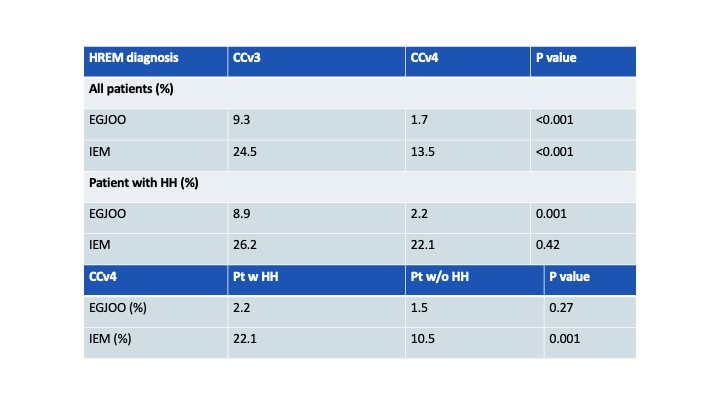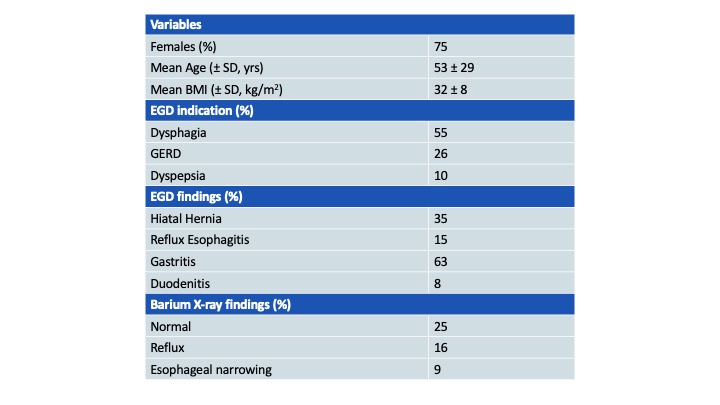Sunday Poster Session
Category: Esophagus
P0614 - Comparison of Chicago Classification v3.0 and v4.0 for Motility Disorder Diagnoses in Patients With Hiatal Hernia
Sunday, October 26, 2025
3:30 PM - 7:00 PM PDT
Location: Exhibit Hall

Misha Gautam, MD (she/her/hers)
University of Missouri - Kansas City School of Medicine
Kansas City, MO
Presenting Author(s)
Misha Gautam, MD1, Vinay Jahagirdar, MD2, Abbas Bader, 1, Priyanka Kumar, 1, Tarek Odah, MD3, Jagadish Koyi, MD1, Mir Zulqarnain, MD1, Tahar Malek. Mahmoudi, MD1, Esmat Sadeddin, MD4, Hassan Ghoz, MD4
1University of Missouri - Kansas City School of Medicine, Kansas City, MO; 2Virginia Commonwealth University Medical Center, Richmond, VA; 3Mayo Clinic, Jacksonville, FL; 4University of Missouri Kansas City School of Medicine, Kansas City, MO
Introduction: The introduction of Chicago Classification version 3.0 (CCv3) in 2014 led to increased diagnoses of esophagogastric junction outflow obstruction (EGJOO) and ineffective esophageal motility (IEM), including findings of uncertain clinical significance. In response, version 4.0 (CCv4) revised diagnostic criteria to enhance clinical relevance. Given the frequent coexistence of hiatal hernia (HH) with EGJOO and IEM, in this study we aimed to evaluate the effect of CCv4 on motility disorder diagnoses in patients with and without HH.
Methods: We retrospectively reviewed patients who underwent high-resolution esophageal manometry (HREM) between January 1 and May 31, 2013, and collected clinical, endoscopic, and radiologic data. We reassessed manometry findings using both CCv3 and CCv4 and compared patients with and without HH. We performed statistical analysis using chi-square tests, with significance set at p< 0.05.
Results: Among 421 patients (75% female, mean age 53±29 years, BMI 32±8 kg/m²), the most common indications for HREM were dysphagia (55%) and GERD (26%). HH was present in 149 (35%) patients. Under CCv3, EGJOO and IEM were diagnosed in 9.3% and 24.5% of all patients, respectively. These rates significantly declined to 1.7% and 13.5% under CCv4 (both p< 0.001). In patients with HH, EGJOO diagnosis decreased from 8.9% (CCv3) to 2.2% (CCv4, p=0.001), while IEM rates remained similar (26.2% vs 22.1%, p=0.42). Under CCv4, patients with HH had significantly higher rates of IEM than those without HH (22.1% vs 10.5%, p=0.001), but EGJOO rates were comparable (2.2% vs 1.5%, p=0.27). None of the patients with HH and EGJOO required surgical intervention.
Discussion: CCv4 significantly reduced the diagnosis of EGJOO and IEM, aligning manometric findings more closely with clinical relevance. In patients with HH, EGJOO was more selectively diagnosed under CCv4, while IEM remained prevalent—likely reflecting underlying reflux pathology. These findings support CCv4’s refinement goals and underscore the importance of contextual interpretation of manometry in the presence of HH to avoid overdiagnosis and unnecessary interventions.

Figure: Baseline Clinical Characteristics of Patients Undergoing High-Resolution Esophageal Manometry (HREM)
Demographic information, indications for testing, and relevant findings from esophagogastroduodenoscopy (EGD) and barium radiography are summarized for the study cohort (n = 421).

Figure: Comparison of HREM Diagnoses Using Chicago Classification v3.0 and v4.0 in Patients With and Without Hiatal Hernia (HH)
Rates of esophagogastric junction outflow obstruction (EGJOO) and ineffective esophageal motility (IEM) are shown for all patients and stratified by presence of HH. Diagnosis compared between CCv3 and CCv4, and between HH vs non-HH groups using CCv4.
Disclosures:
Misha Gautam indicated no relevant financial relationships.
Vinay Jahagirdar indicated no relevant financial relationships.
Abbas Bader indicated no relevant financial relationships.
Priyanka Kumar indicated no relevant financial relationships.
Tarek Odah indicated no relevant financial relationships.
Jagadish Koyi indicated no relevant financial relationships.
Mir Zulqarnain indicated no relevant financial relationships.
Tahar Mahmoudi indicated no relevant financial relationships.
Esmat Sadeddin indicated no relevant financial relationships.
Hassan Ghoz indicated no relevant financial relationships.
Misha Gautam, MD1, Vinay Jahagirdar, MD2, Abbas Bader, 1, Priyanka Kumar, 1, Tarek Odah, MD3, Jagadish Koyi, MD1, Mir Zulqarnain, MD1, Tahar Malek. Mahmoudi, MD1, Esmat Sadeddin, MD4, Hassan Ghoz, MD4. P0614 - Comparison of Chicago Classification v3.0 and v4.0 for Motility Disorder Diagnoses in Patients With Hiatal Hernia, ACG 2025 Annual Scientific Meeting Abstracts. Phoenix, AZ: American College of Gastroenterology.
1University of Missouri - Kansas City School of Medicine, Kansas City, MO; 2Virginia Commonwealth University Medical Center, Richmond, VA; 3Mayo Clinic, Jacksonville, FL; 4University of Missouri Kansas City School of Medicine, Kansas City, MO
Introduction: The introduction of Chicago Classification version 3.0 (CCv3) in 2014 led to increased diagnoses of esophagogastric junction outflow obstruction (EGJOO) and ineffective esophageal motility (IEM), including findings of uncertain clinical significance. In response, version 4.0 (CCv4) revised diagnostic criteria to enhance clinical relevance. Given the frequent coexistence of hiatal hernia (HH) with EGJOO and IEM, in this study we aimed to evaluate the effect of CCv4 on motility disorder diagnoses in patients with and without HH.
Methods: We retrospectively reviewed patients who underwent high-resolution esophageal manometry (HREM) between January 1 and May 31, 2013, and collected clinical, endoscopic, and radiologic data. We reassessed manometry findings using both CCv3 and CCv4 and compared patients with and without HH. We performed statistical analysis using chi-square tests, with significance set at p< 0.05.
Results: Among 421 patients (75% female, mean age 53±29 years, BMI 32±8 kg/m²), the most common indications for HREM were dysphagia (55%) and GERD (26%). HH was present in 149 (35%) patients. Under CCv3, EGJOO and IEM were diagnosed in 9.3% and 24.5% of all patients, respectively. These rates significantly declined to 1.7% and 13.5% under CCv4 (both p< 0.001). In patients with HH, EGJOO diagnosis decreased from 8.9% (CCv3) to 2.2% (CCv4, p=0.001), while IEM rates remained similar (26.2% vs 22.1%, p=0.42). Under CCv4, patients with HH had significantly higher rates of IEM than those without HH (22.1% vs 10.5%, p=0.001), but EGJOO rates were comparable (2.2% vs 1.5%, p=0.27). None of the patients with HH and EGJOO required surgical intervention.
Discussion: CCv4 significantly reduced the diagnosis of EGJOO and IEM, aligning manometric findings more closely with clinical relevance. In patients with HH, EGJOO was more selectively diagnosed under CCv4, while IEM remained prevalent—likely reflecting underlying reflux pathology. These findings support CCv4’s refinement goals and underscore the importance of contextual interpretation of manometry in the presence of HH to avoid overdiagnosis and unnecessary interventions.

Figure: Baseline Clinical Characteristics of Patients Undergoing High-Resolution Esophageal Manometry (HREM)
Demographic information, indications for testing, and relevant findings from esophagogastroduodenoscopy (EGD) and barium radiography are summarized for the study cohort (n = 421).

Figure: Comparison of HREM Diagnoses Using Chicago Classification v3.0 and v4.0 in Patients With and Without Hiatal Hernia (HH)
Rates of esophagogastric junction outflow obstruction (EGJOO) and ineffective esophageal motility (IEM) are shown for all patients and stratified by presence of HH. Diagnosis compared between CCv3 and CCv4, and between HH vs non-HH groups using CCv4.
Disclosures:
Misha Gautam indicated no relevant financial relationships.
Vinay Jahagirdar indicated no relevant financial relationships.
Abbas Bader indicated no relevant financial relationships.
Priyanka Kumar indicated no relevant financial relationships.
Tarek Odah indicated no relevant financial relationships.
Jagadish Koyi indicated no relevant financial relationships.
Mir Zulqarnain indicated no relevant financial relationships.
Tahar Mahmoudi indicated no relevant financial relationships.
Esmat Sadeddin indicated no relevant financial relationships.
Hassan Ghoz indicated no relevant financial relationships.
Misha Gautam, MD1, Vinay Jahagirdar, MD2, Abbas Bader, 1, Priyanka Kumar, 1, Tarek Odah, MD3, Jagadish Koyi, MD1, Mir Zulqarnain, MD1, Tahar Malek. Mahmoudi, MD1, Esmat Sadeddin, MD4, Hassan Ghoz, MD4. P0614 - Comparison of Chicago Classification v3.0 and v4.0 for Motility Disorder Diagnoses in Patients With Hiatal Hernia, ACG 2025 Annual Scientific Meeting Abstracts. Phoenix, AZ: American College of Gastroenterology.
